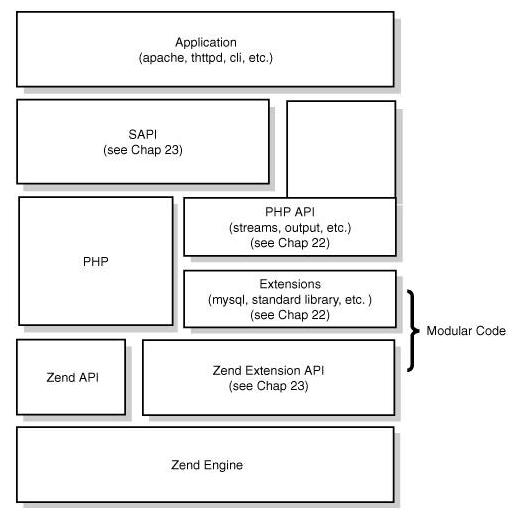关于php内核的SAPI接口。
当在命令行输入:
$ php -r "phpinfo();"
你就会在cli端看到:
phpinfo()
PHP Version => 5.3.13
System => Windows NT CBS-PC 6.1 build 7600 (Windows 7 Business Edition) AMD64
Build Date => May 14 2012 02:46:11
Compiler => MSVC9 (Visual C++ 2008)
Architecture => x64
Configure Command => cscript /nologo configure.js "--enable-snapshot-build" "--with-pdo-oci=C:\php-sdk\php53dev\vc9\x64\deps\instantclient_10_2\sdk,shared" "--with-oci8=C:\php-sdk\php53dev\vc9\x64\deps\
instantclient_10_2\sdk,shared" "--with-oci8-11g=C:\php-sdk\php53dev\vc9\x64\deps\instantclient_11_2\sdk,shared" "--disable-debug-pack" "--disable-static-analyze"
……
通过上面的这个例子,你会看到,当你在命令行输入,shell命令后,执行了php脚本,并且打印到了cli端。那么这个shell命令和php 引擎之间一定有种接口,能将shell的参数,代码,转换成php,然后又将php的标准输入转化成shell ,打印在了终端。
这个接口就叫SAPI(Server Application Programimg Interface)。
由于php程序可以在命令行执行,也可以在web server 上执行,所以在终端上的SAPI就叫做CLI SAPI,在web server 上的SAPI 就叫做CGI SAPI。
脚本执行的开始都是以SAPI接口实现开始的。只是不同的SAPI接口实现会完成他们特定的工作。SAPI提供了一个和外部通信的接口, 对于PHP5.n,默认提供了很多种SAPI。这里主要是看看CGI SAPI的底层实现。
PHP的架构图:

查看 PHP-SRC/sapi/cgi/cgi_main.c
static sapi_module_struct cgi_sapi_module = {
#if PHP_FASTCGI
"cgi-fcgi", /* name */
"CGI/FastCGI", /* pretty name */
#else
"cgi", /* name */
"CGI", /* pretty name */
#endif
php_cgi_startup, /* startup */
php_module_shutdown_wrapper, /* shutdown */
NULL, /* activate */
sapi_cgi_deactivate, /* deactivate */
sapi_cgibin_ub_write, /* unbuffered write */
sapi_cgibin_flush, /* flush */
NULL, /* get uid */
sapi_cgibin_getenv, /* getenv */
php_error, /* error handler */
NULL, /* header handler */
sapi_cgi_send_headers, /* send headers handler */
NULL, /* send header handler */
sapi_cgi_read_post, /* read POST data */
sapi_cgi_read_cookies, /* read Cookies */
sapi_cgi_register_variables, /* register server variables */
sapi_cgi_log_message, /* Log message */
NULL, /* Get request time */
STANDARD_SAPI_MODULE_PROPERTIES
};
ps : 详情请参考鸟哥的技术博客:深入理解Zend SAPIs